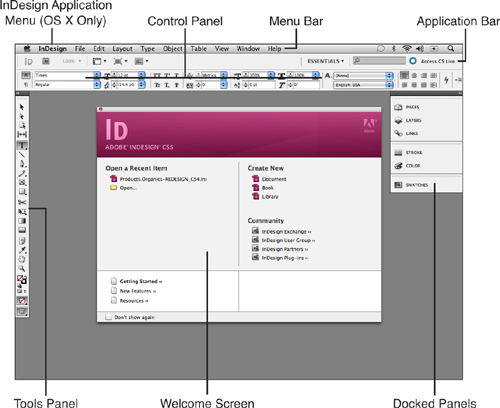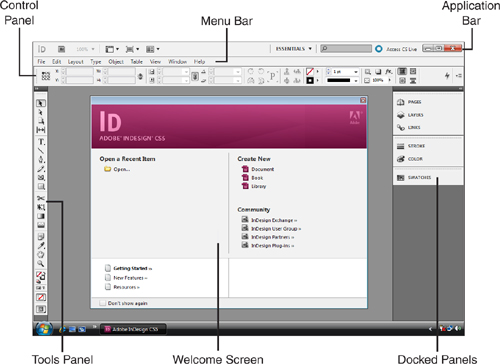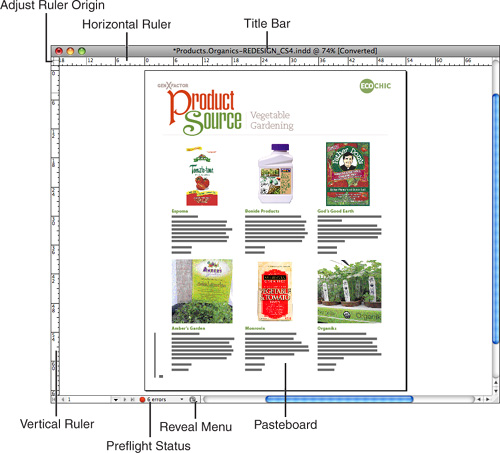|
It doesn’t really matter whether you’re a “Mac
person” or a “PC person” when you’re working in InDesign CS5. For the
most part, the interface controls look and behave the same way on either
Windows XP/Vista/7 or Mac OSX. The exceptions are the usual shortcut
key differences, a few menu commands, and some system-specific buttons
and controls (mostly in regard to printing and exporting documents).
Let’s take a look at the main interface controls in InDesign CS5.
The InDesign CS5 Interface
The InDesign interface
is very intuitive and easy to navigate. Everything you need to work with
and create layout documents is right at your fingertips. The first
interface item you should familiarize yourself with is the Welcome
Screen.
Shown in Figure 1 is the default, Essentials Workspace for InDesign CS5. These are the main elements you will be working with:
Menu Bar: You can access any of the menu list options by clicking any of the word headings in the menu bar. InDesign Application Menu:
This “Mac only” menu provides access to InDesign’s application-specific
options, such as Preferences, as well as some other Mac OS X system
features such as Hiding and Showing. |
In Mac OS X, you can hide
InDesign by Option-clicking anywhere in the desktop area behind the open
document. Note that the Application Frame option must be disabled for
you to do so.
|
Application Bar: View options, zoom percentage, screen mode, and arrange options are all available from the Application Bar drop-down lists. Control Panel: Options for the tool you currently have selected in the Tools panel always appear here. Tools Panel: You can access any of the InDesign tools by clicking one of the icons shown in the Tools panel. Panels:
All the panels can be accessed under the Window menu in the menu bar.
They are listed alphabetically in the main pull-down, but note that some
are grouped into submenus within the list. After they are accessed, all
panels (other than the Tools panel or the Control panel) appear docked
on the right side of your screen, but can also be relocated within the
dock, grouped with other panels, or released from the dock and left
free-floating. Welcome Screen:
This dialog box appears only when you first launch InDesign. It
contains links for opening recent documents, creating new documents, and accessing the InDesign community
via the Internet. If you’d prefer not to see the Welcome Screen every
time you launch InDesign, enable the Don’t Show Again option located in
the lower-left corner of the dialog box.

|
In Mac OS X or Windows, you
can press Tab to hide all the controls in the interface at once and
focus on the document window. Press Shift+Tab to hide all the panels
except the Tools panel, the Control panel, and the Application Bar.
|
|
The Preferences command, which is located under the InDesign menu in Mac OS X, is located under the Edit menu in Windows.
|

The Document Window
Anytime you open or start a
new document InDesign places it in its own document window. You can
view all the pages in your document within this window (see Figure 3).

The document window includes the following items;
Title Bar: The filename and view magnification percentage are always displayed at the top of the document window in the title bar. Pasteboard:
The work area for creating page layouts and designs is always
surrounded by a thin rule and a hard drop shadow. The white area outside
the pasteboard is not printable. If you Control-click (Mac) or
right-click (Win) in the Pasteboard area, you can access various
commands, depending on which tool you currently have selected. Adjust Ruler Origin: Click and drag to change the zero point in your document (the point of origin for your rulers). Double-clicking this area resets the zero point to the top-left corner. Page Access:
In the bottom-left corner of the document window are controls for
accessing specific pages in the document. The number that is displayed
indicates which page you are currently viewing in the document window.
Click the arrow to the right of it to select a different page from the
footer menu, or double-click in the text field to type in the number of
the page you’d like to view. A group of arrow buttons enables you to
access the next spread, previous spread, and first or last page of the
document. Preflight Status:
By default, InDesign’s Preflight option is always on, which allows
InDesign to automatically check for document errors in the background
while you work. InDesign displays any Preflight prepress check errors
that it finds in the document at the bottom of the window. Click the
arrow to the right of the status display to select different Preflight
options from the footer menu. Reveal Menu:
Click the Reveal Menu button at the bottom of the document window to
choose a display option from the footer menu. You can choose to reveal
the document in the Finder (Mac), Explorer (Win), Bridge, or Mini
Bridge. Rulers: When visible, the rulers always surround the top and left sides of a layout in the document window.
Hiding/Showing Rulers
To display the document rulers, follow these steps:
1. | To show or hide the rulers in a document window, choose View, Show/Hide Rulers or press Cmd-R (Mac) or Ctrl+R (Win).
| 2. | To
choose the unit of measurement that you’d like to display in each
ruler, choose InDesign, Preferences, Units and Increments (Mac) or Edit,
Preferences, Units and Increments (Win) to access the Units and
Increments panel of the Preferences dialog box.
| 3. | Select
an option from the Ruler Units area of the panel. Note that each ruler
(Horizontal and Vertical) has a separate drop-down list, which enables
you to select a different measurement unit for each ruler.
|
|
You can also change units
and ruler display options by Control-clicking (Mac) or right-clicking in
the ruler area and choosing a command from the contextual menu.
|
The ruler area also enables you to click and drag guidelines (referred to as ruler guides)
onto the pasteboard. Hold down Shift as you click and drag to snap the
guide to the nearest ruler increment. Double-click in the ruler area to
add a guide at that exact measurement point on the page. |